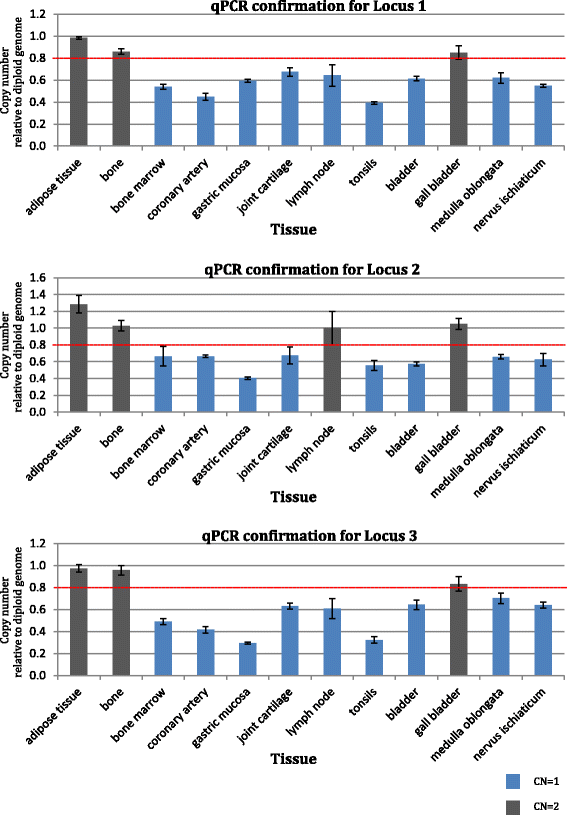Somatic mosaicism for copy-neutral loss of heterozygosity and DNA copy number variations in the human genome
- PMID: 26376747
- PMCID: PMC4573927
- DOI: 10.1186/s12864-015-1916-3
Somatic mosaicism for copy-neutral loss of heterozygosity and DNA copy number variations in the human genome
Abstract
Background: Somatic mosaicism denotes the presence of genetically distinct populations of somatic cells in one individual who has developed from a single fertilised oocyte. Mosaicism may result from a mutation that occurs during postzygotic development and is propagated to only a subset of the adult cells. Our aim was to investigate both somatic mosaicism for copy-neutral loss of heterozygosity (cn-LOH) events and DNA copy number variations (CNVs) in fully differentiated tissues.
Results: We studied panels of tissue samples (11-12 tissues per individual) from four autopsy subjects using high-resolution Illumina HumanOmniExpress-12 BeadChips to reveal the presence of possible intra-individual tissue-specific cn-LOH and CNV patterns. We detected five mosaic cn-LOH regions >5 Mb in some tissue samples in three out of four individuals. We also detected three CNVs that affected only a portion of the tissues studied in one out of four individuals. These three somatic CNVs range from 123 to 796 kb and are also found in the general population. An attempt was made to explain the succession of genomic events that led to the observed somatic genetic mosaicism under the assumption that the specific mosaic patterns of CNV and cn-LOH changes reflect their formation during the postzygotic embryonic development of germinal layers and organ systems.
Conclusions: Our results give further support to the idea that somatic mosaicism for CNVs, and also cn-LOHs, is a common phenomenon in phenotypically normal humans. Thus, the examination of only a single tissue might not provide enough information to diagnose potentially deleterious CNVs within an individual. During routine CNV and cn-LOH analysis, DNA derived from a buccal swab can be used in addition to blood DNA to get information about the CNV/cn-LOH content in tissues of both mesodermal and ectodermal origin. Currently, the real frequency and possible phenotypic consequences of both CNVs and cn-LOHs that display somatic mosaicism remain largely unknown. To answer these questions, future studies should involve larger cohorts of individuals and a range of tissues.
Figures

Similar articles
-
Genome-wide analysis of recurrent copy-number alterations and copy-neutral loss of heterozygosity in head and neck squamous cell carcinoma.J Oral Pathol Med. 2014 Jan;43(1):20-7. doi: 10.1111/jop.12087. Epub 2013 Jun 10. J Oral Pathol Med. 2014. PMID: 23750501
-
aCNViewer: Comprehensive genome-wide visualization of absolute copy number and copy neutral variations.PLoS One. 2017 Dec 19;12(12):e0189334. doi: 10.1371/journal.pone.0189334. eCollection 2017. PLoS One. 2017. PMID: 29261730 Free PMC article.
-
Somatic Mosaicism in Bulls Estimated from Genome-Wide CNV Array and TSPY Gene Copy Numbers.Cytogenet Genome Res. 2016;149(3):176-181. doi: 10.1159/000448368. Epub 2016 Aug 18. Cytogenet Genome Res. 2016. PMID: 27532433
-
Assessing copy number abnormalities and copy-neutral loss-of-heterozygosity across the genome as best practice in diagnostic evaluation of acute myeloid leukemia: An evidence-based review from the cancer genomics consortium (CGC) myeloid neoplasms working group.Cancer Genet. 2018 Dec;228-229:218-235. doi: 10.1016/j.cancergen.2018.07.005. Epub 2018 Oct 6. Cancer Genet. 2018. PMID: 30344013 Review.
-
Contrasting mechanisms of de novo copy number mutagenesis suggest the existence of different classes of environmental copy number mutagens.Environ Mol Mutagen. 2016 Jan;57(1):3-9. doi: 10.1002/em.21967. Epub 2015 Aug 6. Environ Mol Mutagen. 2016. PMID: 26247157 Review.
Cited by
-
A Link between Genetic Disorders and Cellular Impairment, Using Human Induced Pluripotent Stem Cells to Reveal the Functional Consequences of Copy Number Variations in the Central Nervous System-A Close Look at Chromosome 15.Int J Mol Sci. 2020 Mar 9;21(5):1860. doi: 10.3390/ijms21051860. Int J Mol Sci. 2020. PMID: 32182809 Free PMC article. Review.
-
Imprinted genes and imprinting control regions show predominant intermediate methylation in adult somatic tissues.Epigenomics. 2016 Jun;8(6):789-99. doi: 10.2217/epi.16.8. Epub 2016 Mar 23. Epigenomics. 2016. PMID: 27004446 Free PMC article.
-
Somatic mosaicism in inherited bone marrow failure syndromes.Best Pract Res Clin Haematol. 2021 Jun;34(2):101279. doi: 10.1016/j.beha.2021.101279. Epub 2021 Jun 27. Best Pract Res Clin Haematol. 2021. PMID: 34404533 Free PMC article. Review.
-
The fetal thymus has a unique genomic copy number profile resulting from physiological T cell receptor gene rearrangement.Sci Rep. 2016 Mar 24;6:23500. doi: 10.1038/srep23500. Sci Rep. 2016. PMID: 27009469 Free PMC article.
-
iPSCs and fibroblast subclones from the same fibroblast population contain comparable levels of sequence variations.Proc Natl Acad Sci U S A. 2017 Feb 21;114(8):1964-1969. doi: 10.1073/pnas.1616035114. Epub 2017 Feb 6. Proc Natl Acad Sci U S A. 2017. PMID: 28167771 Free PMC article.
References
Publication types
MeSH terms
LinkOut - more resources
Full Text Sources
Other Literature Sources
Miscellaneous

